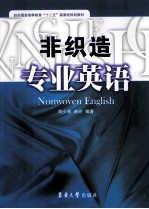

非织造专业英语 纺织服装PDF电子书下载
- 电子书积分:10 积分如何计算积分?
- 作 者:薛少林,韩玲编著
- 出 版 社:上海:东华大学出版社
- 出版年份:2013
- ISBN:9787566901958
- 页数:211 页
CHAPTER 1 GENERAL INTRODUCTION 1
1.1 DEFINITION OF NONWOVENS 1
1.1.1 Definition of INDA 1
1.1.2 Definition of EDANA 1
1.1.3 Definition of ASTM 1
1.2 CLASSIFICATION OF NONWOVENS 2
1.3 DEVELOPMENT OF NONWOVENS 3
1.3.1 History and Background 3
1.3.2 Trends in Materials,Process and New Products 4
CHAPTER 2 FIBERS FOR NONWOVENS 6
2.1 INTRODUCTION 6
2.2 CELLULOSIC NATURAL FIBERS 8
2.2.1 Cotton 8
2.2.2 Flax 9
2.2.3 Hemp 9
2.2.4 Jute 10
2.2.5 Ramie 10
2.3 PROTEIN NATURAL FIBERS 13
2.3.1 Wool 13
2.3.2 Silk 13
2.3.3 Camel Hair 14
2.3.4 Mohair 14
2.4 REGENERATED FIBERS 16
2.4.1 Rayon 16
2.4.2 Cellulose Acetate 18
2.4.3 Lyocell 20
2.5 SYNTHETIC FIBERS 25
2.5.1 Olefin Fiber 25
2.5.2 Polyester 30
2.5.3 Nylon Fibers 32
2.5.4 Acrylic 35
2.5.5 Carbon Fibers 36
CHAPTER 3 WEB FORMATION TECHNOLOGIES OF NONWOVENS 42
3.1 DRY LAID PROCESS 43
3.1.1 Fiber Selection 43
3.1.2 Fiber Preparation 43
3.1.3 Web Forming 44
3.1.4 Laying 46
3.2 WET-LAID PROCESS 51
3.2.1 Paper and Textiles 51
3.2.2 Raw Materials 51
3.2.3 Production Machinery 53
3.2.4 Special Features of the Wet-1aid Process and Its Products 55
3.3 SPUN-LAID PROCESS 58
3.3.1 Polymer 58
3.3.2 Spinning and Web Formation 59
3.3.3 Characteristics and Properties 61
3.3.4 Applications 61
3.4 MELT BLOWN PROCESS 63
3.4.1 Polymer Type 64
3.4.2 Processing 64
3.4.3 Web Characteristics and Properties 68
3.4.4 Process Structure Property 69
3.4.5 Applications 70
3.4.6 Comparison of Melt Blown and Spunbond 71
CHAPTER 4 WEB BONDING TECHNOLOGIES OF NONWOVENS 74
4.1 CHEMICAL BONDING PROCESS 74
4.1.1 Bonding Agents(Binders) 74
4.1.2 Chemical Bonding Processes 76
4.1.3 Applications 79
4.2 NEEDLEPUNCHING PROCESS 80
4.2.1 Process 80
4.2.2 Mechanism of Needle Loom 80
4.2.3 Felting Needle 81
4.2.4 Types of Needle Looms 82
4.2.5 Machine Variable 84
4.2.6 Applications 84
4.3 SPUNLACING PROCESS 85
4.3.1 Process 86
4.3.2 Materials Used in Spunlaced Technology 87
4.3.3 Parameter Affecting the Product Performance 89
4.3.4 Properties of Spunlaced Fabrics 90
4.3.5 Applications 91
4.4 THERMAL BONDING PROCESS 93
4.4.1 Binders 94
4.4.2 Methods of Thermal Bonding 95
4.4.3 Advantages and Energy Comparison 98
4.5 STITCH BONDING PROCESS 100
4.5.1 Batt Bonded by Threads 100
4.5.2 Stitch Bonding Without Threads 101
CHAPTER 5 NONWOVENS FINISHING 102
5.1 INTRODUCTION 102
5.2 SURFACE FINISHING 103
5.2.1 Calendering 103
5.2.2 Embossing 104
5.2.3 Pressing 104
5.2.4 Singeing,Splitting,Grinding and Velouring 104
5.3 SHAPE FINSHING 106
5.3.1 Shrinkage 106
5.3.2 Wrenching 107
5.3.3 Creeping,Perforating and Slitting 107
5.4 WET FINISHING 110
5.4.1 Washing 110
5.4.2 Dyeing 111
5.4.3 Printing 112
5.5 CHEMICAL FINISHES 114
5.5.1 Antistats 115
5.5.2 Antimicrobials 115
5.5.3 Water Repellents 115
5.5.4 Lubricants 116
5.5.5 UV Absorbers and Polymer Stabilizers 116
5.5.6 Flame Retardants 116
5.5.7 Softeners 117
5.5.8 Absorbency and Rewetters 117
5.5.9 Thermoplastic Binders,Resins and Emulsion Polymers 117
5.5.10 Thermosetting Resins and Crosslinking Agents 117
5.5.11 Soil Release 117
5.5.12 Optical Brighteners 118
5.6 COATING 121
5.6.1 Chemical Vapour Deposition and Physical vapour Deposition 121
5.6.2 Electro Deposition 121
5.6.3 Spray Coating 122
5.7 LAMINATING AND FLOCKING 122
CHAPTER 6 PRODUCTS AND APPLICATIONS OF NONWOVENS 124
6.1 HEALTHCARE AND HYGIENE 124
6.1.1 Absorbent Hygiene Products 124
6.1.2 Healthcare and Medical Application 128
6.2 INDUSTRIAL APPLICATIONS 134
6.2.1 Automotive 134
6.2.2 Building 137
6.2.3 Cable Wrapping 139
6.2.4 Filtration 139
6.2.5 Industrial and Institutional Wipes 141
6.3 PACKAGING AND AGRICULTURE 145
6.3.1 Packaging 145
6.3.2 Agriculture and Horticulture 146
6.3.3 Landscaping Fabric 149
6.4 GEOTEXTILE 151
6.4.1 Geotextile Classifications 151
6.4.2 Geotextile Types 153
6.4.3 Essential Functions of Geotextiles 153
6.5 FURNISHINGS 156
6.6 NONWOVENS IN APPAREL INDUSTRY 159
6.6.1 Protective Dress 159
6.6.2 Fashion Apparel 160
CHAPTER 7 NONWOVENS TESTING 163
7.1 NONWOVENS CHARACTERIZATIONS 163
7.2 TESTING STANDARDS 165
7.3 TESTING CLASSIFICATION AND BASIC TESTS ITEMS 166
7.4 TESTING METHODS AND TECHNIQUE 168
7.4.1 Absorbency-capacity Tests 168
7.4.2 Electrostatic Properties 170
7.4.3 Flammability and Optical Properties 170
7.4.4 Permeability and Porosity 170
7.4.5 Filtration 172
7.4.6 Strength 174
7.4.7 Softness 175
7.4.8 Barrier 175
7.4.9 Contamination 176
CHAPTER 8 NEW TECHNOLOGIES FOR NONWOVENS 182
8.1 NEW PRODUCTS FROM BIOCOMPONENTS 182
8.2 NANOFIBER NONWOVENS 186
8.2.1 Electrospinning Process 187
8.2.2 Properties of Nanofibers 188
8.2.3 Applications of Nanofibers 188
8.2.4 Challenges in Nanofibers 191
8.3 GREEN OR ENVIRONMENT-FRIENDLY NONWOVENS 192
8.4 SMART TEXTILES 194
8.4.1 Definition of Intelligent Clothing 194
8.4.2 Nonwoven Confortable Fabrics with Electric Circuits 194
8.4.3 Stretchable Nonwovens 196
词汇总表 199
- 《实用服装外贸英语》王桂祥 2019
- 《动漫人物四季服装 绘画设计 基本知识+配色设计+穿搭方案 全彩版》韩李贤美著;胡梅丽译 2017
- 《功能性纺织产品功能性评价及检测》党敏主编 2019
- 《服装专业英语》王勇编著 2019
- 《事业单位公开招聘分类考试专用教材 综合应用能力 B类 社会科学专技类 2018中公版》李永新 2018
- 《纺织产品生态安全性能检测》田文主编 2019
- 《纺织染料降解催化剂》米立伟,卫武涛著 2019
- 《河南省纺织类经典非物质文化遗产》赵宏 2017
- 《服装面料与辅料手册 第2版》邢声远 2020
- 《纺织品检测实务 第2版》翁毅 2018
- 《市政工程基础》杨岚编著 2009
- 《家畜百宝 猪、牛、羊、鸡的综合利用》山西省商业厅组织技术处编著 1959
- 《《道德经》200句》崇贤书院编著 2018
- 《高级英语阅读与听说教程》刘秀梅编著 2019
- 《计算机网络与通信基础》谢雨飞,田启川编著 2019
- 《看图自学吉他弹唱教程》陈飞编著 2019
- 《法语词汇认知联想记忆法》刘莲编著 2020
- 《培智学校义务教育实验教科书教师教学用书 生活适应 二年级 上》人民教育出版社,课程教材研究所,特殊教育课程教材研究中心编著 2019
- 《国家社科基金项目申报规范 技巧与案例 第3版 2020》文传浩,夏宇编著 2019
- 《流体力学》张扬军,彭杰,诸葛伟林编著 2019
